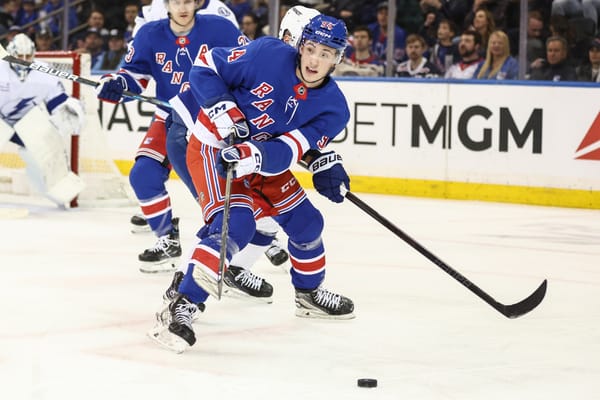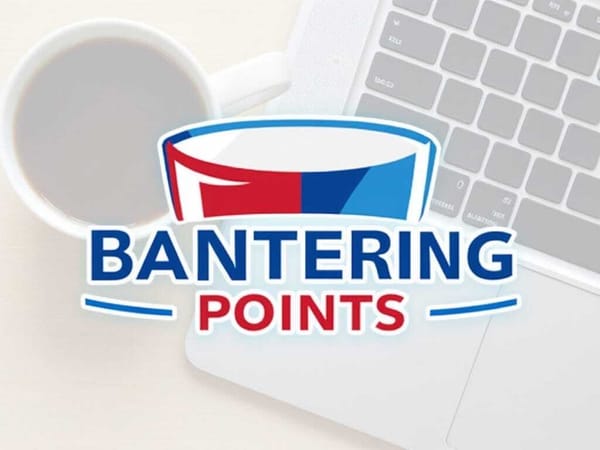Blueshirt Banter 2018 New York Rangers Prospect Rankings: 30-26
30. Riley Hughes, Right Wing
2017 Ranking: N/A
Age: 18
Acquired Via: 2018 Draft (Seventh Round)
The Rangers moved a 2019 seventh-round pick in order to move back into the 2018 seventh round and take Riley Hughes.
Afterwards, I watched a few of Hughes’ games. His skill on the puck is evident. He is very patient and has soft hands, and so I saw him make some creative, perfectly weighted passes. Here are two examples (look for #12 in red).
He’s also a pretty good scorer. He has a good shot and, again, plenty of skill to make creative plays.
I have heard concerns about Hughes’ play off the puck. I only watched a few games, but in those games that didn’t appear to be a notable problem. He covered his checks and aggressively pressured the points to take away space and try to force turnovers. He’s not overly physical, but he gets his stick in on players and adjusts quickly on backchecks. Here are a couple of examples (again, #12 in red).
The reason Hughes was available so late in the draft is because he is extremely raw. His skating needs a lot of work, as his strides are laborious and he doesn’t generate speed quickly. He reminds of of 2017 sixth-round pick Morgan Barron in that he has a number of crude individual qualities and will need a lot of hands-on guidance over the course of multiple years to be effective.
I don’t think Hughes was a steal or anything like that, but he was a reasonable selection in the seventh round. If you look at late-round picks who beat the odds and made the NHL, they tend to fit one of two categories. They either were passed on in earlier rounds because of some major concern (injuries, size, attitude, etc), or because they played at a low level. Hughes slots into the latter category. He played high school hockey and has limited experience in meaningful international tournaments.
Hughes is a long-shot prospect, but so is any seventh-round pick. The Rangers made a reasonable investment in an enigma whom they can stash away for four seasons. Hughes will move to the USHL next season before attending Northeastern University in the Fall of 2019.
29. Vinni Lettieri, Right Wing
2017 Ranking: 31
Age: 23
Acquired Via: Free Agency (2017)
When the Rangers signed Lettieri out of the University of Minnesota, I didn’t think anything of it. He was a perfectly capable college player, but I did not see him as a meaningful NHL prospect.
Admittedly, I was kind of wrong. He was very impressive during the preseason, and I thought he deserved an NHL spot. Throughout the season, though, he earned 19 NHL games from a few separate call-ups, producing a goal in his first NHL game against Detroit. In Hartford, he was arguably the team’s top forward.
Lettieri is a great skater, works hard to pursue pucks, and has some skill. His underlying numbers in the NHL were very poor. Of course, the dynamic last season was not exactly great for any player, let alone a rookie trying to prove he belongs.
I am interested in seeing how he does under a different set of circumstances. It had to have been incredibly difficult find a role on a team that was dying on the vine with every passing game and under orders from a head coach on the chopping block. In a less stressful environment that will allow for development, maybe Lettieri will have the time to turn those flashes of ability into a more consistent, shift-by-shift presence. He’ll certainly have a chance to earn a roster spot in training camp.
In terms of players ranked outside the top-15 or so, Lettieri might have the highest likelihood of achieving an NHL career. His relatively low rank is due to lack of upside. I think he might become a good fourth liner, which is perfectly fine. Even if they hold a lower likelihood of success, prospects who have the potential to turn into bigger contributors are preferable.
28. Calle Sjalin, Left Defense
2017 Ranking: 17
Age: 18
Acquired Via: 2017 Draft (Fourth Round)
(Written by European Correspondent Tobias Pettersson)
Själin started the Allsvenskan (Swedish second tier) season well. He was in Leksand’s top-four (mostly right defense on the top pairing) and he drove play for them even though he didn’t feature on the box score. A couple months into the season, Själin first got ill and then suffered a concussion which kept him out for quite a while. In that span Leksand started winning and Minnesota Wild first-round pick Filip Johansson emerged in his spot. When Själin was healthy again he lost his place on the team. He spent the rest of the season mostly as the seventh defenseman with limited icetime. He ended the season with 24 games, three assists and a positive relative Corsi For Percentage.
In international play he featured for Sweden U20 in three games where he didn’t stand out but then had a really solid U19 five nations tournament in the spring. He could be a dark horse for Swedens World Junior squad if he features in Leksands top-four and does well.
He has the talent to take back his spot but Leksand does have a very strong D group for Allsvenskan. Personally I hoped he would change teams because Leksand is the kind of team which buys their way out of trouble so they’re less likely to be patient with a prospect. With that said, he should feature as a top-six defenseman with room for a bigger role.
27. Lauri Pajuniemi, Right Wing
2017 Ranking: N/A
Age: 18
Acquired Via: 2018 Draft (Fifth Round)
(Written by European Correspondent Alex Nunn)
Lauri Pajuniemi spent most of the 2017/18 season getting his feet wet at senior level in Finland after a late-September call-up by TPS from their U20 roster. His immediate adjustment was mixed in a fourth-line role which regularly saw players come and go beside him, but he stuck to the spot and flirted with top-six minutes on more than one occasion.
While it’s foolish to suggest that Pajuniemi’s outstanding 17-year-old season for TPS U18 – 76 points in 45 games and second through league history behind only Eeli Tolvanen – is a true indication of what the Rangers’ 2018 fifth-round pick can do, he does notably have a proven track record of production at all levels without ever icing alongside top line-mates.
Aside from a need to better read plays in the defensive zone, there are not a ton of things Pajuniemi should really consider a weakness at this stage. His offensive game is nicely rounded and the key building blocks (smarts, skating) are in place. High-end tools are a question mark, but Pajuniemi has a settled base to build from and 2018/19 should see him afforded a much bigger opportunity with TPS.
26. Tyler Wall, Goaltender
2017 Ranking: 10
Age: 20
Acquired Via: 2016 Draft (Sixth Round)
After what I’d describe as a B-plus/A-minus 2016-2017 season for Tyler Wall,I felt he had an outside shot at making Canada’s World Junior team for 2018. He played very well for Umass-Lowell and was a big reason Umass-Lowell won the Hockey East Conference.
Last season, though, could not have gone much worse for Wall. He had a poor start to the season, and his confidence was clearly affected. Christoffer Hernberg, the backup goaltender, played very well in his starts and eventually took hold of the starting job. Wall finished his sophomore season with an .868 save percentage in just 12 games, after posting a .918 save percentage in 37 games his freshman year.
Clearly, Wall has earned a drop down the rankings, but I think the optics of falling from 10 to 26 are worse than the actual substance of it. It speaks to his poor season, but also how much talent the Rangers have added to the prospect pool. Last season was a setback, but he is still very young and raw. He has already proven he can play at the NCAA level and deserves the benefit of the doubt. He’ll head back to Umass-Lowell for his junior season and will have to earn back the starting job.




